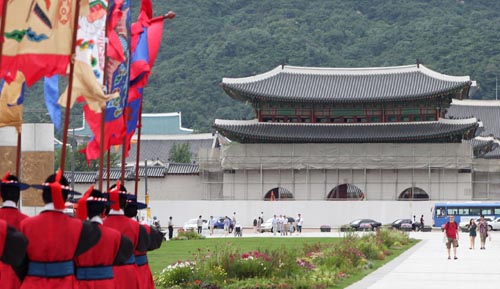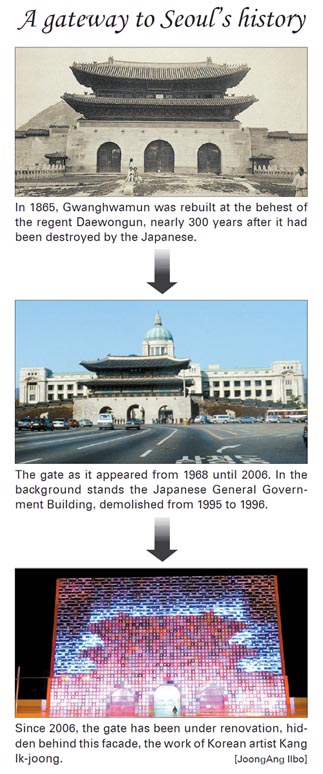Restoring a royal landmark

Re-enactors parade near the new gate on July 28. By Park Ji-hye
One of Korea’s most important landmarks is in a new location.
True, the gate known as Gwanghwamun may look like it’s in the same place at the entrance to Gyeongbok Palace, watching over Sejongno - the closest thing Seoul has to a main street.
But in fact, the treasure - recently reassembled and still covered in a few sheets and scaffolds - has been shifted 13.5 meters (44 feet) to the west and 11.5 meters to the south. It was also rotated 3.75 degrees clockwise, according to Lee Jai-seo, deputy director of the Cultural Heritage Administration.
Why the slight shift? The administration says it has simply put the gate back where it belongs.
Built by the first king of the Joseon Dynasty in 1395, the gate was destroyed during the Japanese invasion of Korea in 1592. It wasn’t rebuilt until 1865, when the powerful regent Heungseon Daewongun decided to restore the ravaged Gyeongbok grounds. It’s this version of the southern main gate that the reconstruction team has worked to replicate.
During the Japanese colonial era (1910-1945), the Japanese moved Gwanghwamun to the east side of the palace to give the new General Government Building a clear view down Sejongno in 1927. In fact, the Japanese tried to destroy the gate outright, but Korean intellectuals successfully petitioned for its preservation. Tragically, Gwanghwamun was again destroyed during the Korean War in 1951.
In 1968, Gwanghwamun was restored for a third time by President Park Chung Hee, this time in concrete.
Though it was moved back to roughly its original location, considerations were made to account for traffic flow on Sejongno.

But the unveiling does not arrive without controversy. When the Cultural Heritage Administration moved up the opening of the restored Gwanghwamun from the end of 2010 to September and then ultimately to Aug. 15 - ahead of the 100th anniversary of Japanese annexation - critics worried that it might have come under political pressure to have the landmark ready for the G-20 Summit in November. Head carpenter Shin Eung-soo assured the public that he agreed to the early opening because construction finished ahead of schedule.
“I would never allow the construction period to be shortened unless it was possible,” Shin said. “The restoration was originally scheduled to be finished by the end of 2009, but the construction of Gwanghwamun Plaza delayed the unveiling date a little in fact.” Shin added that the construction crew and the Cultural Heritage Administration had been discussing moving up the date since early 2010.
But there’s another outstanding issue: the words that will hang over the gate’s arched entrance. Since the beginning of the process, the builders have planned to restore the Chinese characters reading “Gwanghwamun” that hung on the gate from the reign of King Gojong of Joseon until the gate’s destruction in 1951.
The lettering is set to be based on photos taken around 1916, which depict calligraphy by Im Tae-young, the general who directed Gwanghwamun’s first rebuilding, according to Gyeongbok Palace records.
But from 1968 to 2006, Gwanghwamun bore a signboard in the native Hangeul alphabet written by President Park, and some civic groups have argued that the new gate should also bear a Korean label.
Lee Dae-ro, director general of the Hanmalgeul Association, or Korean Language Association, has insisted that the signboard should be written in Hunminjeongeum, the original form of Hangeul created by King Sejong. Lee has also pointed out that the name Gwanghwamun, or “Spreading Enlightenment Gate,” was first assigned to it during Sejong’s rule in 1425. When the gate was first built in 1395, it was named Sajeongmun, or South Main Gate.
“Since the reconstruction is happening right now when Koreans use the Korean alphabet, following exactly what was there in the Joseon Dynasty does not reflect the true meaning of the restoration of a cultural asset,” said Lee.
However, the administration has stood firm about returning the original Chinese characters to the gate, regardless of criticism. The new signboard was inscribed last week and will be hung, covered in protective cloth, until the grand reopening.
“We are going to proceed as planned. The purpose of this restoration is to have Gwanghwamun reborn in the form that was there in the late Joseon Dynasty,“ said Deputy Director Lee of the Cultural Heritage Association.
With just a week left before the big day, squabbling still continues over the reconstruction process at Gwanghwamun. Because of the many forms it has taken, it would be impossible to restore the gate to any definitive historical state.
But the team’s commitment to reviving the spirit of the Joseon Dynasty can be felt with a glance at Seoul’s beautiful old landmark made new again.
By Lee Sun-min [summerlee@joongang.co.kr]










with the Korea JoongAng Daily
To write comments, please log in to one of the accounts.
Standards Board Policy (0/250자)